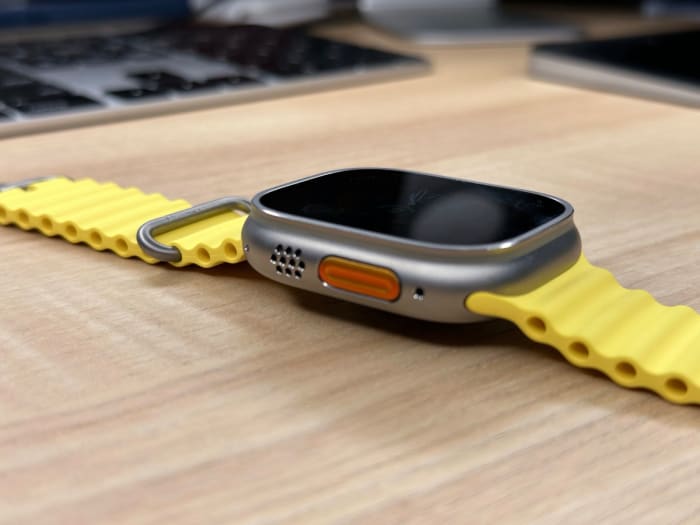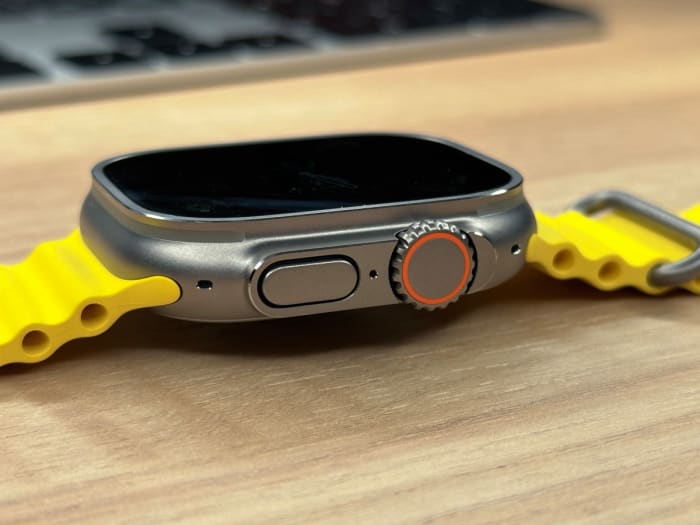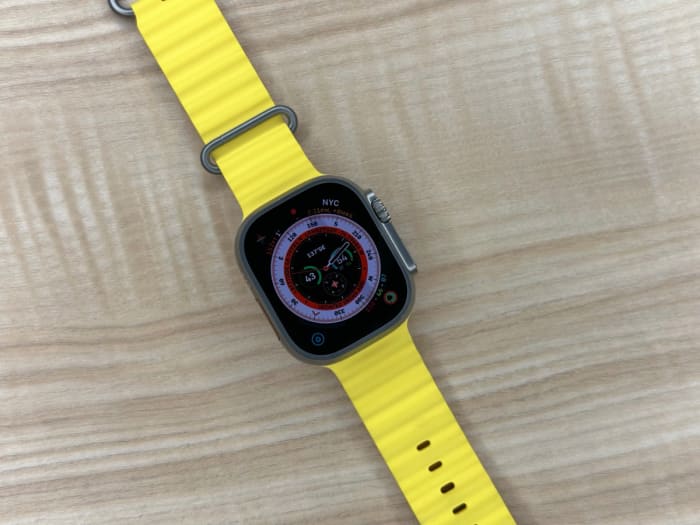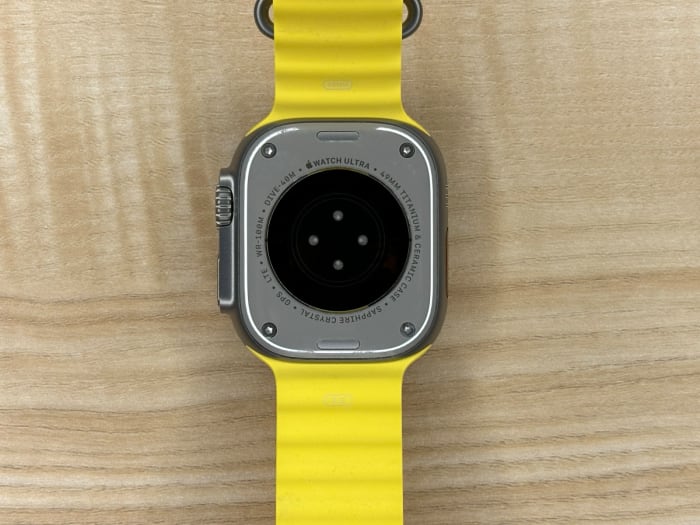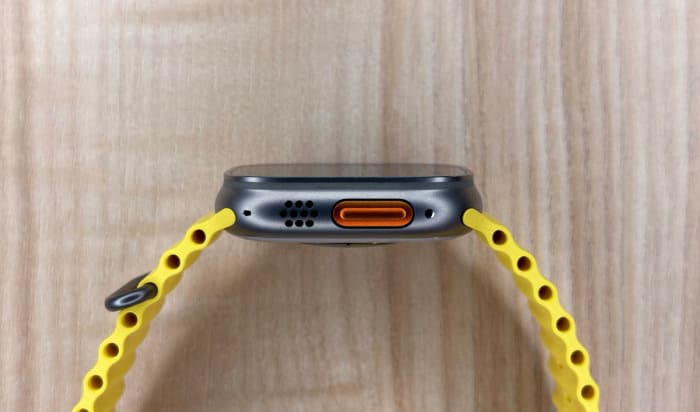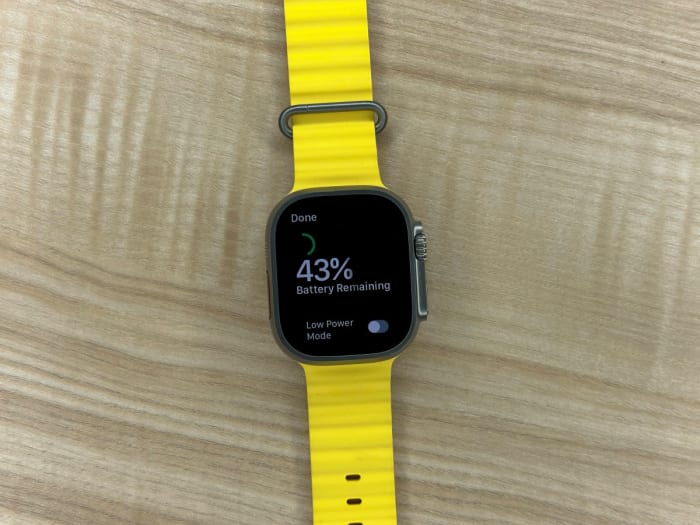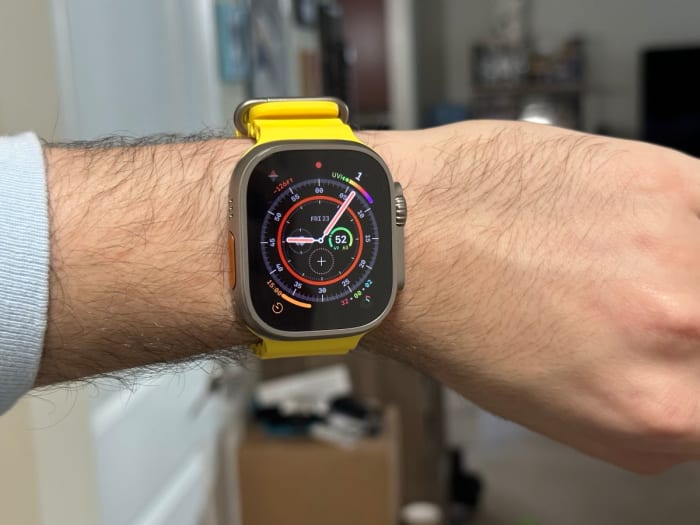Apple Watch Ultra Review: For Everyday Epics
I’ve been wearing an Apple Watch daily since the first day it became available in 2015. Since then, Apple’s wearable has always been fit for the everyday and the more adventurous. The watchOS software has evolved and lets you view notifications, take a call from your wrist, and track really any activity. What’s changed is mainly in the world of health as the device delivered more advanced tracking.
But the general design and layout has stayed the same. Until now. The Apple Watch Ultra ($800) is a product that’s designed for adventure and geared for serious athletes. It boasts more advanced GPS, a bigger and more rugged build, longer battery life, an action button, and the latest sensor stack.
But after using it for 25 days, it’s clear that the Apple Watch Ultra is not only ready for those epic adventures, but it’s also terrific for the everyday ones.
Contents
- A Chunky But Light Build
- A Flat Display That’s Bigger and Brighter
- Ready for Any Adventure
- Terrific Battery Life
- Bottom Line: Is the Apple Watch Ultra Worth It?
A Chunky But Light Build
Ever since I strapped on the Apple Watch Ultra, it felt like a wrist computer. And it now looks more like one seen on a superhero than ever before with a silver titanium finish and a bright, poppy yellow Ocean Band.
The Apple Watch Ultra is the largest smartwatch that Apple has ever crafted — it’s a 49-mm face that stretches beyond the 45-mm of the Series 8 and well beyond the smaller 41-mm size. The unboxing experience is pretty next level, and, when you first pick up the Ultra, it gives off a look that it will be heavy.
And while it is chunkier than a typical Apple Watch, it’s surprisingly lightweight, mainly thanks to its titanium build (which also makes it extra durable and rugged). It weighs in at just 61.3 grams or 0.14 pounds. I have a pretty petite wrist, but the Ultra sits pretty comfortably. Coming from the 45-mm Series 7 or 8, it’s only a tad bigger on the wrist. Those who prefer a small watch should look elsewhere, though.
Those coming from another Apple Watch will feel at home. The right handside still contains a button and the Digital Crown, but it’s in new housing. There’s an ovular piece of titanium that juts out of this side and wraps the crown. This way if you take a tumble or knock the Apple Watch into a hard surface — be it a corner table or a piece of rock while mountain climbing — the Digital Crown won’t be accidentally hit, scratched or cracked.
The Digital Crown here is larger—Apple says it’s 30% bigger than other watches—and it makes it easier to turn or click in. Though with the latter, when selecting an item on the screen or pushing in to see all of your apps, you need to apply a bit more pressure. And since I’ve encountered some chiller weather in the great state of New Jersey, I can confirm that even with gloves on you can control the crown and this classic button. Remember that a double tap engages Apple Pay, a single tap pulls up multitasking, and a long hold will get you into the power menu. Flanking these main controls is a depth gauge for diving and a microphone.
The right side of the Ultra still contains holes for the speaker and a microphone, but there’s also a sliver of bright orange. This is the new “Action Button,” which is customizable to let you quickly start a workout, engage a light or really any of the actions available. To be specific, it’s a shade of International Orange and it’s one of my favorite features of the Ultra.
You can quickly tap it to instantly start recording a workout. This is handy for an avid yogi, a marathon runner or even someone like me who frequently engages the same workout. After all, it lets me focus on my Peloton class with Hannah Corbin and hit my metrics. You can also customize it to quickly turn on a flashlight or trigger it to run a Shortcut. The latter is basically a routine I can set up, so this can turn on the lights or engage some other action. I’m also hoping that Apple will open this up for more developers to take advantage of the potential here.
The rear side of the Apple Watch Ultra looks like any other Apple Watch. Since the Ultra only comes in titanium, all of these feature a flat back with the classic circle that raises out a bit, and this part holds the sensor stack. And as you’d expect from an $800 device, the Ultra offers every health and activity feature that any Apple Watch is capable of.
Here’s some good news: the 49-mm Ultra is compatible with any Apple Watch bands that are designed for the larger size. Meaning that a 42- or 45-mm band can be slid and locked into place. The mechanism for attaching them remains the same. And alongside the Ultra are three new bands that Apple purposely designed for different activities.
The Ocean Band is designed to get wet with a design that can fit around a wetsuit. This has been my favorite and it’s built for a polymer elastomer, each portion of the band has ridges that are kind of like mini tunnels. I also tested the new Alpine Loop, which is made out of two layers of textiles and closes with a hook fashion. It’s quite comfortable on the wrist.
And as the name suggests, the Ultra goes farther than any other Apple Watch in terms of ruggedness and durability. Yes, Titanium is strong but the Ultra is also rated for depths of up to 100 meters of water. That’s twice the rating from other Apple Watches and it can also be used for recreational diving which is at a maximum of 40 meters. There’s even a depth app which can track how far you go on the screen — it engages at three feet.
A Flat Display That’s Bigger and Brighter
Alongside the titanium frame and the larger build, the other big change with the Apple Watch Ultra is a larger display that is flat. Meaning that the titanium frame actually raises over the display slightly. Unlike the Apple Watch Series 7 or Series 8 which featured a display that actually sloped over the sides a bit, the 49-mm display here is flat. It also looks sharp in nearly any condition.
Specifically, this 49-mm display is an Always-On Retina screen, which means that it never fully goes off. So even if you’re not engaging with it, you can glance at your wrist to see your watch face. It gets very vibrant and bright, even to the point where it was comfortable to view photos on my wrist alongside more expected activities on Apple Watch.
The larger display here makes it easier to hit anything on the screen — from using the QWERTY keyboard to respond to a message or an email, to scrolling through photos, calculating a tip in the calculator, monitoring weather conditions and to even dialing a number. Similarly, controlling music playback via Apple Music or Spotify is easier.
An extra five millimeters over the biggest Series 8 size might seem small on paper, but it makes a big difference. Especially if you’re utilizing the compass function while on a hike or opting for Maps to navigate through New York City. I didn’t even feel the need to pull out my iPhone when I was trying to figure out the fastest route to catch a train. I could easily glance down at my wrist to see instructions and felt the haptic vibrations for when it was time to turn or when I was approaching an intersection.
I’ve also found myself relying more on the Apple Watch with the larger screen on the Ultra and since all models of this watch feature cellular capability, I can feel more sure of fully leaving the iPhone at home. I have a device with a big enough screen for important alerts and to even respond with messages back.
Apple frequently expands the available watch faces and the Ultra has an exclusive one. Wayfinder packs a ton of complications (aka mini widgets that you can customize) around the typical clock face. It also features a night mode which changes the colorful face into all red, which makes it easy to view in the dark.
Ready for Any Adventure
Apple has been clear that the Ultra was designed for adventure, specifically for folks who roam outdoors, tackle the ocean with a certain eagerness, and climb mountains. But it’s also for everyday adventurers. So yes, the Apple Watch Ultra is designed for marathoners and mountaineers; it’s capable of tracking in those environments and lasting the entire trek. But it’s also an extraordinary unit for the everyday adventurer.
Like the Series 8, this $800 smartwatch features Apple’s latest health stack. The Apple Watch Ultra can track really any workout from an indoor walk to an outdoor run with dance, HIIT, yoga, meditation, a swim and a cycle in between. But it’s also up to the task for these health metrics:
- Heart rate and electrocardiogram (ECG)
- Blood oxygen (Sp02)
- Sleep tracking with stages like light, deep and REM
- Temperature sensing
- Fall detection
It tracks all of these through a sensor stack that also includes gyroscopes and accelerometers. At the center, though, is an optical heart rate sensor (second gen), electrical heart rate sensor, two temperature sensors (one for environmental and one for the wrist), along with a blood oxygen sensor. The Ultra also boasts enhanced GPS with L1 and L5 bands, a compass, an altimeter and a few others.
All of this comes together for a smartwatch that can track pretty much anything … both when you engage with it and in the background. And in my testing, these heart-tracking features are up to snuff with other Apple Watches, competing watches like Samsung’s Galaxy Watch as well as other wearables.
The larger screen here is great for workouts. For example, while at the launch event for Lululemon Studio, I used the Apple Watch Ultra to track a HIIT workout, then a boxing one, then yoga, meditation and dance. While on my wrist, I could see a ton of detail from my heart rate, calories burned and other specifics to each workout. I didn’t need to fiddle around with the Digital Crown or a swipe to see more data.
Similarly, I used the Apple Watch Ultra to track an indoor cycle on a Peloton bike to monitor my workout. And then I could use it for a mindful cooldown through Apple Fitness+. The Ultra will let you take advantage of new workout types that rolled out with watchOS 9 as well. This is good news for athletes of any kind with heart-rate zones, the ability to create a multisport workout, tracking power and even form for runners.
The other advantage is the new “Compass” app, which is also on the Series 8 and SE (second gen). It shines on the Ultra’s 49-mm screen as you can have it track a hike, mark points along the way — including picking an icon and using the QWERTY keyboard to name it (i.e., pond or parked car) — and see your route appear on your wrist. You can turn around to see distances calculated in real time as to what you’re facing.
And if you get lost, like I did, in a reservation in N.J., you can use the backtrack function. With this, it will sketch out the route you took in reverse to give you a map to follow. This could be really helpful if you’re lost in a city or while out in the desert.
There’s one other hardware addition which could come in handy in the wilderness or for a walk home. The Apple Watch Ultra has a siren built in that can reach a full 86 decibels and stretch for about 600 feet. In my test it started with a few high-pitched tones and then played the international SOS sound. I tested this in the New Jersey suburbs, and it was pretty evident that it was reaching a few blocks.
Another safety feature baked into the Apple Watch Ultra is “Car Crash Detection” which uses a bevy of sensors, including a barometer, and a bunch of AI and ML training that Apple has worked on. This essentially gives it the ability to track a severe car crash and then prompt the device to call emergency services.
Alongside heart-rate tracking, the ability to take an ECG and monitor blood oxygen levels, the new addition also accounts for skin temperature level. This works through two new pieces of hardware: a wrist temperature sensor, which sits close to your wrist, and one under the display which senses the environment. This way it can factor in the conditions around you to get an accurate read. The end result here isn’t opening the Health app on your iPhone or your wrist to view the current temperature, rather this tracks over time and establishes a baseline. This way it can show you trends and tell you if you’ve risen above or below that. It also takes at least five nights to establish the baseline.
The idea here is that over time, being above or below this baseline could correlate with someone feeling better or worse. Maybe it has to do with stress or with being ill, but it’s more of a long game here.
This new sensor can also elevate the cycle tracking experience on the Apple Watch. If you’re already using this feature, the Ultra can help to provide more data around your menstrual cycle and ovulation. Essentially this is tracking a biphasic shift, which correlates to a higher temperature or a lower temperature and changing hormones.
Apple is clear that this isn’t predicting the future, either ovulation or period occurrence, but rather providing historical data to help insights. You could see if it correlates with ovulation and then get an estimate that is more borne through data. With the added data from temperature, it can make predictions as to when your period might start by looking back historically.
I have not been able to test this, so I’m not going to provide an analysis here. But it is an important step in making this more accessible to more folks and hopefully further spreading education. This does come at a time when Roe v. Wade has been overturned and there are concerns about having this data accessible. Apple maintains that it is committed to privacy and that this data is locked on your Apple Watch and iPhone, meaning that it would need your encrypted authentication (likely two-step unless you’ve disabled this) to access this information
All of this to say that the Apple Watch Ultra is very capable — whether you’re using it locally as you move from home to the office, whether that’s in your home or somewhere far, additionally scaling to those who run 5Ks, 10Ks or full marathons or who are planning a trek to the top of a mountain.
Terrific Battery Life
Apple has finally put a bigger battery inside an Apple Watch, which makes sense with the Ultra since it’s physically larger and has more room. But this Apple Watch solves the issue of battery life that couldn’t really stretch farther. With a full 100% charge on a normal day with a workout or two, tons of messages, and even a few calls with a bevy of notifications coming through, the Ultra lasted for at least a day and a half. And that includes being used for sleep tracking overnight.
That whole scenario was previously unheard of and borderline impossible on an Apple Watch. Apple says the Ultra is rated for 36 hours and that’s a really impressive feat. You can engage low power mode (which turns off connectivity, background health monitoring and the always-on display function) to stretch the life to nearly 60 hours. In my testing this came close to three full days of use.
Recharging it is also wicked fast.When paired with a higher-powered wall plug and the new charging cable, the Ultra was back to nearly 100% in about 40 minutes. I’ll also call out that the included cable features a braided design that feels premium.
Sitting alongside this terrific battery life is the overall performance of the Apple Watch Ultra. Like the other 2022 Apple Watches — Series 8 and SE (second gen) — the Ultra is powered by Apple’s S8 system on a chip. It gives you plenty of power to swiftly open, close and use really any application that is on your wrist. I also didn’t experience any crashes when using the Ultra and I expect it to be supported for many years into the future.
Bottom Line: Is the Apple Watch Ultra Worth It?
The Apple Watch Ultra is the most advanced Apple Watch ever, ideal for someone who wants a sport-focused Apple Watch that can be taken into the ocean for a dive, on a trek to a mountain, and then used on the ride home and while you’re sitting at a desk. Unlike specific watches designed for diving or running, the Apple Watch Ultra manages to blend the two activities together.
Yes, it costs a hefty sum, but it’s an Apple Watch that’s ultimately ready for anything and gives you a larger screen with long battery life to last until the final mile. If you’re not after the bigger screen and the advanced capabilities, or just don’t wish to pay the premium price, the Apple Watch Series 8 is also best-in-class as a traditional smartwatch, blending convenience with health features and a starting price of just $399 ($429 for cellular). And if you don’t need an always-on display or all the health features, the Apple Watch SE is just $249. That’s an unbeatable value.
But what about someone like me? I’m an editor, a nerd who loves technology, and someone who’s pretty active and eager to toss new workouts in. To me, the Apple Watch Ultra lets me go farther and pairs it with a computer on my wrist. It’s an Apple Watch that’s ready for the everyday and the far-away epic, and that’s something to get behind. I won’t be going back.
Prices are accurate and items in stock at time of publishing.
